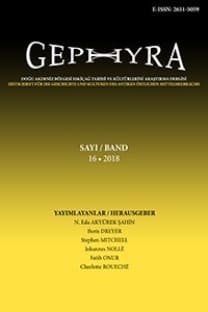Zeus Larasios’un Cariyeleri (Pallakai)
Tralleis’ten (Aydın) Zeus Larasios’a sunulan adaklardan MS ikinci yüzyıl sonu ya da üçüncü yüzyıl başına tarihlenen iki yazıtlı kaide, ilkinin 19. yüzyılda yayınlanmasından bu yana tekrar tekrar tartışılmıştır. Tartışmanın çıkış noktası, sunuları adayan kadınların kendilerini pallakai (cariyeler) olarak tanımlamaları olmuştur; bu, kalıtsal olan ve bir yaşam boyunca yalnızca bir kez (ya da istisnai durumlarda iki kez) sahip olunabilen kutsal bir işlevdir. Beş yılda bir kullanılan Zeus Larasios festivalde pallakai tarafından her dört yılda bir yerine getirilen görevler konusunda araştırmacılar arasında bir fikir birliği yoktur. W. Ramsey tarafından 1883 yılında ortaya atılan kutsal fahişeler oldukları hipotezi terk edilmiştir. K. Latte’nin pallakai’ı (Pythia modelinde) kâhin olarak kabul etme önerisi de sorunludur. Antik sözlükbilimcilerin pallake ya da pallakis terimini ergenliğin başlangıcındaki genç kız olarak açıklamaları, Zeus Larasios’un pallakai’ının çocukluktan üreme çağına geçişi işaret eden bir ritüel gerçekleştirdiklerini düşündürmektedir. Strabon, Mısır Tebai’ında bu türden bir ritüel kaydetmiştir.
The Pallakai of Zeus Larasios
Two inscribed bases of votive offerings to Zeus Larasios from Tralleis (Aydin), dating from the late second or early third century AD, have been repeatedly discussed ever since the first of them was published in the 19th century. The starting point of the discussion has been the fact that the women who dedicated the offerings identify themselves as pallakai (concubines), a sacred function that was hereditary and could be held only once (or in exceptional cases twice) in a lifetime. There is no agreement among scholars on the duties performed by the pallakai every four years, on the occasion of the penteteric festival of Zeus Larasios. The hypothesis that they were sacred prostitutes, put forward by W. Ramsey in 1883, has been abandoned. The proposal of K. Latte to recognize the pallakai as prophetesses (on the model of the Pythia) is also problematic. The explanation of the term pallake or pallakis by ancient lexicographers as a young girl at the beginning of puberty suggests that the pallakai of Zeus Larasios performed a ritual signaling the transition from childhood to reproductive age. Strabo records a ritual of this kind in Egyptian Thebes.
___
- S. L. Budin, Pallakai, Prostitutes and Prophetesses, CP 98, 2003, 148-159.
- S. L. Budin, The Myth of Sacred Prostitution in Antiquity, Cambridge 2008.
- A. Chaniotis – J. Mylonopoulos, Epigraphic Bulletin for Greek Religion 2004 (EBGR 2004), Kernos 20, 2007, 229-327.
- A. B. Cook, Zeus: a study in ancient religion I-III, Cambridge 1914-1940.
- P. Debord, L’esclavage sacré: état de la question, in : Actes du colloque 1971 sur l’esclavage (Annales Littéraires de l'Université de Besançon, 140), Paris 1972.
- P. Debord, Aspects sociaux et économiques de la vie religieuse dans l’Anatolie gréco-romaine (EPRO 88), Leiden 1982.
- H. Erbse, Untersuchungen zu den attizistischen Lexika (Abhandlungen der Deutschen Akademie der Wissenschaften zu Berlin. Philologisch-historische Klasse, Jahrgang 1949 Nr. 2), Berlin 1950.
- W. Fauth, Sakrale Prostitution im Vorderen Orient und im Mittelmeerraum, JbAC 31, 1988), 24-39.
- C. H. E. Haspels, The Highlands of Phrygia: Sites and Monuments, Princeton, N.J. 1971.
- A. Hermary, Les textes antiques ont-ils créé le mythe d’une prostitution sacrée à Chypre ?, Cahiers du Centre d’Études Chypriotes 44, 2014), 239-260.
- F. Poljakof, Die Inschriften von Tralleis und Nysa. 1. Die Inschriften von Tralleis (Inschriften griechischer Städte aus Kleinasien 36, 1), Bonn 1981.
- K. Latte, RE XVIII 1 (1939) 840 s.v. Orakel (= Kleine Schriften zu Religion, Recht, Literatur und Sprache der Griechen und Römer, München 1968, 164).
- K. Latte, The Coming of the Pythia, HThR 33, 1940, 9-18.
- B. Legras, La prostitution féminine dans l’Égypte ptolémaïque, in: G. Thür – J. Vélissaropoulou-Karakostas (edd.), Symposion 1995: Vorträge zur griechischen und hellenistischen Rechtsgeschichte (Korfu, 1-5 September 1995), Weimar-Wien1997, 249-264.
- V. Palmieri (ed.), Herennius Philo. De diversis verborum significationibus, Napoli 1988.
- G. Petzl, Kleine Beiträge zu griechischen Inschriften aus Smyrna, ZPE 13, 1974, 117-126.
- J. F. Quack, Herodot, Strabo und die Pallakide von Theben, in: T. S. Scheer (ed.), Tempelprostitution im Altertum. Fakten und Fiktionen, Berlin 2009, 154-182.
- St. Radt ed.), Strabons Geographica. Mit Übersetzung und Kommentar. Band 8. Buch XIV-XVII: Kommentar. Göttingen 2009.
- W. M. Ramsey, Unedited inscriptions from Asia Minor, BCH, 1883, 258-278.
- L. Robert, Études anatoliennes, Paris 1937.
- ISSN: 1309-3924
- Yayın Aralığı: Yılda 2 Sayı
- Başlangıç: 2004
- Yayıncı: Nalan Eda AKYÜREK ŞAHİN
Sayıdaki Diğer Makaleler
Tlos Tiyatro Tapınağı’ndan İki Yeni Yazıt
Taner KORKUT, M. Ertan YILDIZ, Ş. Recai TEKOĞLU
Urartu Epigrafisinin Rolü: I. Argisti'nin Verzeqan Kentinde Bulunan Yeni Disk
مریم DARA, Hossein NASERİ SOMEEH
Zeus Larasios’un Cariyeleri (Pallakai)
Likya Şiirlerinin İncelenmesinde Metodolojik Hususlar
Bilecik’ten Yeni Mezar Epigramları
Gregor STAAB, Nalan Eda AKYÜREK ŞAHİN, Hüseyin UZUNOĞLU
